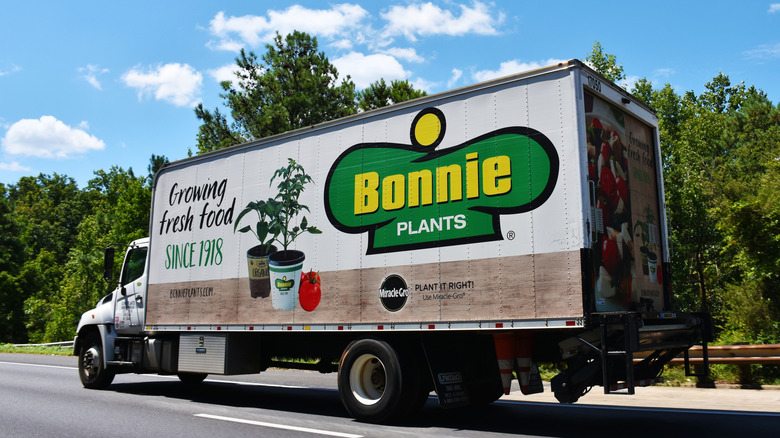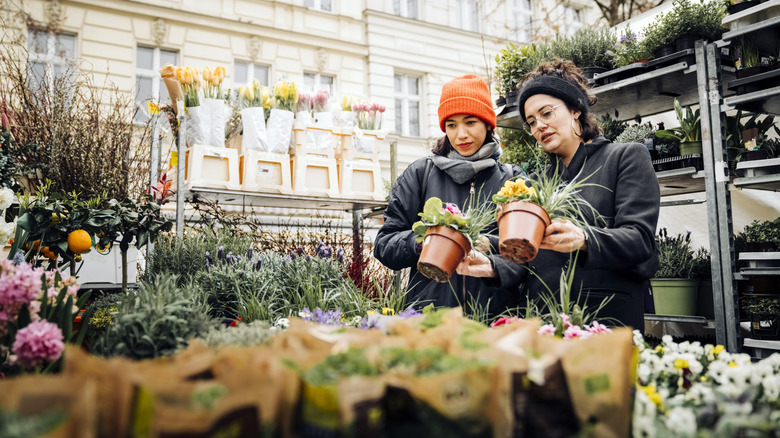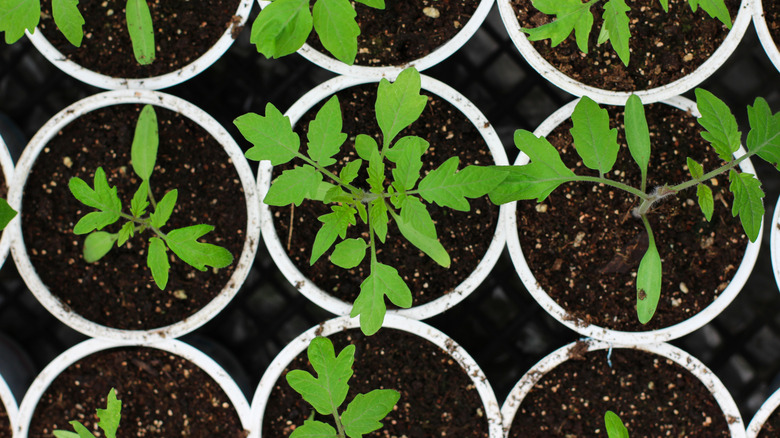Skip The Tasteless Tomatoes At The Garden Center. Here Are Better Options
We can all probably agree that the flavor of most of the tomatoes you buy in the produce section of the grocery store is pathetic compared to a fresh, juicy tomato straight off your backyard plant — or, at least it should be. When you put your blood, sweat, and tears (often a result of said blood) into growing tomatoes, you deserve the best tasting veggie you've ever had. However, if you're buying your tomato plants at big box stores or garden center chains, that first bite may be a disappointment.
Sure, I'm House Digest's Garden Editor and in-house Master Gardener, but I'm also just a grower who likes a good tomato on my sandwich. Or by itself while standing in the garden in my pajamas. Don't judge. Anyway, once I reach the point of my PJ-clad tomato harvest in the summer, I'm looking for a slightly acidic, sweet bite literally dripping with tomato flavor. What I won't be happy about is something that tastes like the tomatoes on my Subway sandwich. (Sorry, Subway, that's not your fault).
When this happens, it's because I'm trying the varieties sold at these stores. They aren't bred for exceptional flavor. Instead, they're grown in massive quantities because they travel well and can tolerate some negligence while they're in the care of the store. Buying your plants from local sellers or starting your own from seed can spare you a great deal of frustration and open a world of tasty tomato species.
The pratfalls of big name sellers at garden centers
I won't say that there are no benefits to buying your tomatoes from big box stores and garden centers. One such benefit is consistency. Bonnie plants, for example, sells plants all over the country, and you can go to your local Walmart or Lowe's and almost certainly find all the 'Celebrity' tomato plants you can squeeze into your garden.
Here's my issue with this situation: The hybrid species you'll find sold by these big-name producers just aren't that great. The flavor of 'Celebrity', 'Better Boy', or other common cultivars you'll find are essentially the flavor equivalent of off-brand Dr. Pepper or Oreos — good enough, but you'd rather have the real thing. In recent years, these plant sellers have started including a few heirloom species into their line up. You might find Cherokee purple, one of my favorites, at your local store, and they've recently added German queen beefsteak, but that's about it.
If you're looking for a cherry tomato with exceptional flavor, you won't find Peacevine plants at any of these stores, nor are you likely to find any of the large array of fabulously colorful heirlooms that range from white to almost black. Still, if you're new to gardening or you've gotten a late start, buying tomato plants at places like Home Depot is better than nothing. And, the harvest will still taste superior to what you'll find in the produce department.
A better option: Where to shop for tomato plants and what to look for
Before you head to the garden center to buy a bunch of plants, make a few stops to see what other sellers have. I've found that locally owned plant nurseries tend to have an excellent selection of both cultivated and heirloom tomato varieties. I like to grow a combination of my tried-and-true favorites — those I know grow well in my climate, provide a good harvest, and taste great — and a few new types to see if I can add to my favorites. Farmer's markets are also an excellent place to look for interesting tomato species, and the seller can probably tell you everything you want to know about that plant. Plus, it's always a good idea to support your local farmers.
One of the things I love most about growing heirloom species is that you can save your own tomato seeds. Heirloom seeds are open-pollinated, which means fruits grown from saved seeds are often true or similar to the parent plant. Tomatoes are self-pollinating, as each bloom has male and female parts, but cross-pollination can happen between plants. If you want to ensure your saved seeds are true to the species, try reusing mesh jewelry bags.
When you're shopping, keep in mind that although heirloom plants have some natural protection against disease, cultivated species (like 'Rutgers VF') are bred to be resistant to certain viruses and diseases. If you've had these issues in the past, look for plants that have these letters behind the cultivar name.
The best choice: Growing tomatoes from seed
There are so many benefits of starting seeds instead of buying plants. Tied for first place are cost and variety. Even local sellers are limited to what they have in stock, but the world's your oyster (or garden catalog) when you are able to start your own seeds. According to NC State Extension, there are over 10,000 species of tomatoes available to grow in the United States at the bargain price of just a few bucks for a packet of seeds. When you consider that vast number of options, it makes the standard plants available at the local garden center seem kind of sad.
Starting seeds isn't for everyone, though. You need a good set-up with sufficient light in a warm spot. Of course, I have my personal preference for the best way to start seeds indoors, but you can have fun and start small by experimenting with a few interesting species of tomatoes. Whether you love what you're growing this year or not, remember a few things: You have definitely learned something, and your harvest will still probably be better than anything you'll find at the store. If it's not, there are still 9,999-plus varieties you haven't tried yet.



